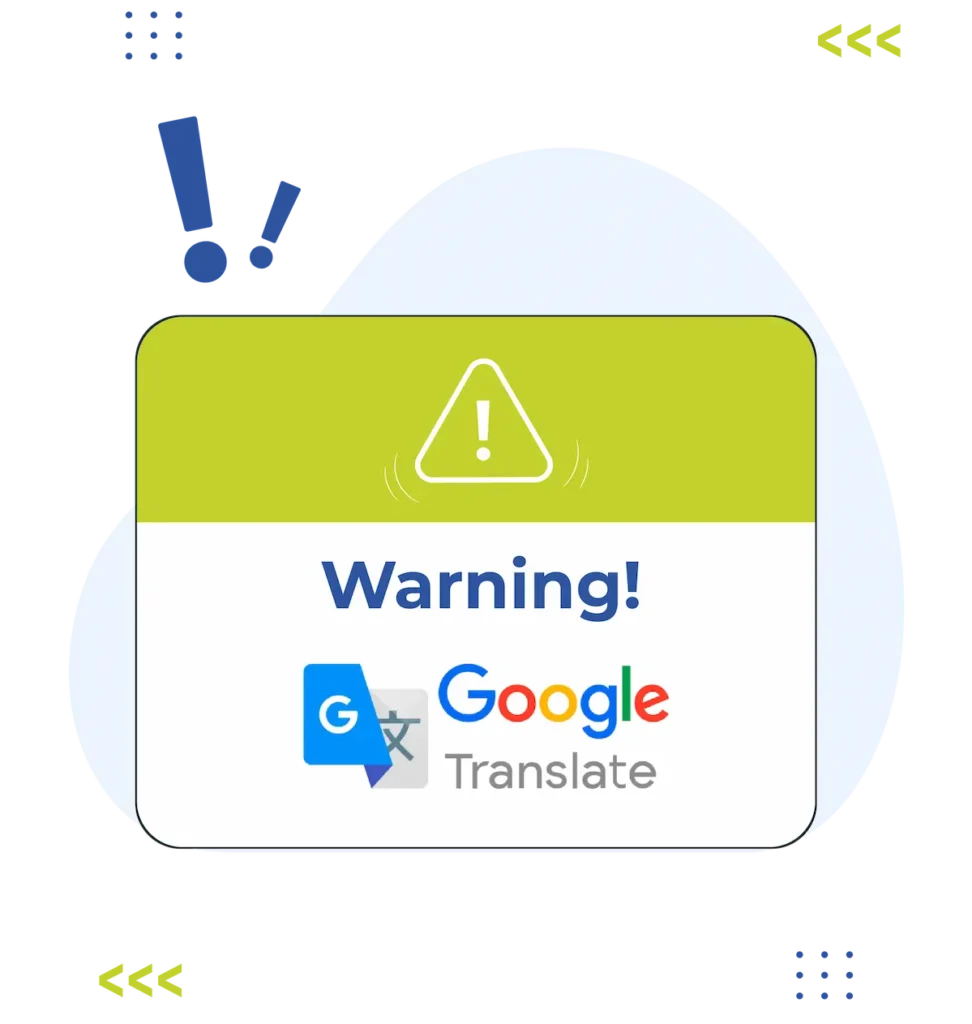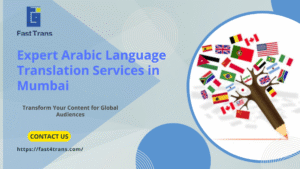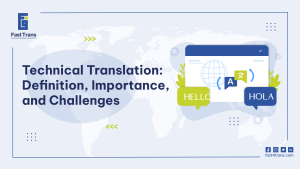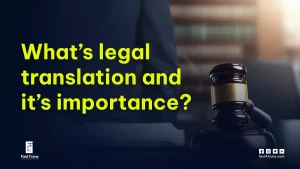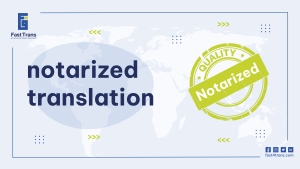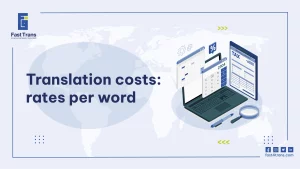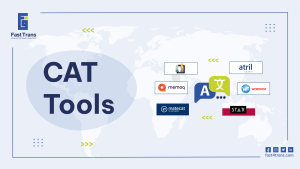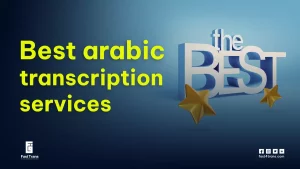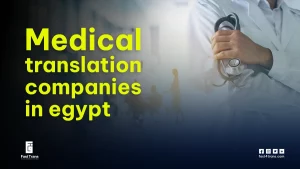There are over 500 million people use Google Translate daily for a variety of purposes. It’s undeniably an effective tool, in plenty of cases, like for a tourist lost on the transportation of a foreign company, or for a student trying to decode a new subject.
Relying on Google Translate for Arabic translations poses serious risks for businesses. Arabic Google Translate Business Risks including misinterpretations of context, inaccurate translations of idiomatic expressions, and failure to capture regional nuances. Its inability to handle complex grammar, specialized jargon, and multiple dialects can lead to costly errors, especially in sensitive fields like law or finance. Without the human touch or proper customization, Google Translate often misses the mark on tone and meaning, risking both accuracy and confidentiality. For high-stakes communications, professional translation services offer a safer, more precise solution tailored to your target audience.
How does Google Translate work?
Almost everyone can recall at least one time when Google made a very funny translation. These are all over the internet. But it makes one wonder, how a tool used by millions makes such a silly mistake, and what’s really going on behind one of the most commonly used Machine Translation tools.
It was launched in 2006, feeding on United Nations documents, and back then it was a statistical machine translation.
In 2016, it became a neural machine translation tool (NMT), which somehow made it better at translating sentences in context and providing relevant translation.
This allows it to model the relationships between words and phrases in different languages. It doesn’t just translate word-for-word; it looks at entire sentences to understand the context and meaning, aiming for more accurate translations.
It supports 243 languages, and although it utilizes NMT, and is still a work in progress.
Read more: Everything you need to know about Google Doc translation
Arabic Google Translate Business Risks
Google Translate faces significant challenges in Arabic translations, including a lack of context awareness, inconsistent quality, and failure to capture regional dialects or cultural nuances. Businesses relying on the tool risk misinterpretations, security concerns, and a loss of tone and accuracy, especially for complex or specialized content.
1. Lack of Human Touch
One of the primary challenges with Google Translate when it comes to Arabic translations is the lack of the human touch, which results in overly robotic, word-for-word translations.
Arabic is a rich and nuanced language, and its translations often miss the intricacies inherent in human translation. Complex texts, idiomatic expressions, and slang present particular difficulties.
For example, when trying to translate phrases like “CX is crucial in the hiring process” from English to Arabic, Google Translate might misinterpret “CX” as “customer experience” rather than “candidate experience”, as it lacks an understanding of the specific context of hiring processes. This problem becomes even more pronounced when handling industry-specific jargon or newly coined terms that Google Translate might not recognize.
2. Inconsistent Quality Across Languages
While Google Translate supports over 240 languages, the quality of translations into Arabic can be inconsistent. Users might find that the tool works well for languages with simpler grammatical structures, but it often falls short when translating into Arabic.
Arabic’s complex grammar, sentence structure, and rich vocabulary pose significant challenges. For instance, users may encounter more issues translating into Arabic compared to languages like Spanish or French. Some professional translators have even reported that Google Translate produces better results for languages with fewer speakers, like Finnish, while Arabic translations still struggle with maintaining the intended meaning, especially in more technical or formal content.
3. Breach of confidentiality
The ease of use that Google Translate offers can also be a double-edged sword. Especially when dealing with sensitive Arabic-language documents—such as financial reports, healthcare records, or legal contracts—there’s a risk of confidentiality being compromised.
Google Translate doesn’t have any built-in data protection agreements (such as an NDA), which means your translated documents could be vulnerable to unauthorized access or even leaked online. In cases where documents contain valuable information, it’s best to avoid relying on Google Translate, or any other translation tool that doesn’t guarantee adequate security.
4. Lack of Contextual Accuracy
The lack of contextual understanding is a common issue with Google Translate, especially when translating into Arabic. This issue arises because machine translation tools, including Google Translate, often fail to grasp the broader context of the content being translated.
Certain phrases in Arabic, like “أنا أشعر باللون الأزرق” (“I am feeling the color blue”), may be inaccurately translated if they are idiomatic in nature, missing the intended meaning of sadness or melancholy, which is conveyed in English as “I’m feeling blue”. Contextual errors like these can lead to confusion or misinterpretation, especially when it comes to complex phrases or cultural references unique to Arabic-speaking countries.
5. Does Not Understand Your Target Audience
Google Translate’s lack of customization makes it less effective for translating content meant for specific Arabic-speaking audiences. Whether you’re creating social media content for a youthful audience in the Gulf or a more formal document for an audience in North Africa, Google Translate generally defaults to a formal tone.
This can be a significant disadvantage when translating marketing materials or social media posts that require a more casual or humorous tone. Additionally, Google Translate is unaware of cultural and regional preferences within the Arabic-speaking world, making it more likely to produce translations that don’t resonate with your audience and may even unintentionally offend them.
6. Can’t Create the Desired Tone
Similar to the issue of not understanding your target audience, Google Translate often struggles to deliver the correct tone in Arabic translations. Whether you’re translating a casual blog post, a webinar, or a tweet, the tool might produce a technically accurate translation, but the tone of the message might be lost.
For example, a friendly, conversational tone in English might translate into something overly formal or distant in Arabic, which can drastically alter the impact of the content.
7. You Will Still Need to Proofread
Even though Google Translate can provide a quick translation into Arabic, it cannot stand alone as a comprehensive translation solution. You will still need to proofread the results carefully to catch common errors in grammar, spelling, and punctuation, especially when translating from languages that differ significantly from Arabic.
While Google Translate may offer a good starting point, it often misses nuances, making it necessary to double-check translations or use additional trusted tools to polish the output. A fun technique is to back-translate the Arabic text into English to spot any inconsistencies or mistakes.
8. Loss of Nuances in Formal Arabic (Classical Arabic vs. Modern Standard Arabic)
Arabic has multiple levels of formality and dialects, and Google Translate may not distinguish between these when translating, especially for formal documents.
For instance, it could translate something intended to be in Classical Arabic (used in religious texts or high-level official documents) into Modern Standard Arabic (used in everyday formal settings), potentially misaligning with the intended tone or target audience. This can especially be problematic for legal, academic, or governmental texts.
9. Handling of Arabic Diacritics
Arabic diacritics (vowel markings) are crucial for determining the meaning of words. Google Translate sometimes misses these subtle yet important diacritical marks, especially when translating informal or unvocalized Arabic text.
This can lead to incorrect translations, especially in contexts where a single word could have multiple meanings depending on the diacritical placement. For example, the word “قلب” could mean “heart” or “turn,” and the tool might misinterpret the context.
10. Challenges with Dialects
Arabic has numerous regional dialects, and Google Translate primarily supports Modern Standard Arabic (MSA). While MSA is widely understood across the Arab world, it is not always the preferred form for informal communication, especially on social media, in marketing content, or in casual conversation.
Google Translate may struggle with dialects such as Egyptian Arabic, Gulf Arabic, or Levantine Arabic, leading to translations that feel unnatural or difficult to understand for native speakers of those dialects.
11. Lack of Sensitivity to Local Laws and Regulations
Google Translate may not be able to effectively handle translations related to local laws, regulations, or compliance, especially if they differ from one Arabic-speaking country to another. For example, legal terminology in Arabic can vary significantly between countries in the Middle East and North Africa (MENA), and an inaccurate translation could have serious consequences in legal contexts.
12. Difficulty with Idiomatic Expressions and Cultural References
As with other languages, Google Translate struggles with idiomatic expressions, proverbs, and cultural references that are unique to Arabic-speaking regions. The inability to accurately translate idioms like “عصفورين بحجر” (literally “two birds with one stone”) or local slang can lead to confusion or miscommunication, particularly in creative or marketing content.
13. Limited Support for Contextual Specialization
When translating highly specialized texts (such as medical, legal, or technical documents) into Arabic, Google Translate may not be able to handle the specific jargon or terminology accurately. The tool may generate inaccurate or overly simplistic translations for technical terms, which could cause misinterpretations, particularly in fields that require precise language like healthcare or law.
14. Dependence on Internet Connectivity
Google Translate is primarily an online tool, meaning that you need a stable internet connection to use it effectively. In situations where internet access is limited or unavailable, relying on Google Translate for Arabic translations becomes impractical. This is especially important for businesses that may need to use the tool in real-time settings like meetings, conferences, or on-site document translations.
15. Security and Privacy Concerns
While Google Translate itself does not store your translations long-term, any information input into the platform could still be processed and analyzed to improve the tool. For businesses dealing with confidential or proprietary information, this raises potential security and privacy risks. Some translations, particularly sensitive data, might be inadvertently exposed to unauthorized access or breaches.
16. Over-reliance on Machine Translation
Over-relying on Google Translate could lead to a diminished perception of the importance of professional human translation services. For business-critical content, such as marketing campaigns, legal documents, or high-level communications, machine translation is often insufficient for ensuring quality and cultural relevance. Relying solely on Google Translate could result in translations that lack the attention to detail necessary to communicate effectively with your Arabic-speaking audience.
When to Trust Google Translate for Arabic:
- Casual Use: For simple translations, casual conversations, or when you’re looking to understand the gist of something quickly, Google Translate is generally reliable.
- Short Phrases or Single Words: For basic word translation or short phrases (e.g., greetings, directions, and simple sentences), it can be fairly accurate.
- Travel and Social Media: Google Translate is great for quick translations when traveling or navigating social media content, especially for general understanding.
When Not to Trust Google Translate for Arabic:
- Legal, Financial, or Medical Documents: For critical business communications, legal contracts, medical information, or financial reports, it’s better to rely on professional translation services.
- Marketing and Branding Content: When translating for advertising, branding, or public relations, the nuances, tone, and local cultural context are crucial. A machine translation might not capture these effectively.
- Long Texts or Complex Sentences: Google Translate may fail with complex or lengthy texts, where its translations might become fragmented or inaccurate, especially when the content is technical or specialized.
GT Errors can be avoided, for good!
Since GT apparently is not optimal for handling translation work for your business. It’s probably a good, if not a fantastic idea to let a translation service provider take the lead on that. That being said, Fast Trans team is among the leading translation and localization service providers who can handle that efficiently, and swiftly. Why?
- Our team comprises native experts because they know the target audience best.
- We have probably worked with your niche before, and know the ins and outs of it.
- More than 120 language support, we’re always ready to hire freelancers to work on a new project if it’s outside our language pair coverage.
- You get your work reviewed by many team members, and into multiple QA stages, to ensure maximum accuracy.
- A rock bottom price, and top-tier quality. Get your free quote here.
Conclusion
Google Translate poses several risks for businesses working with Arabic translations. One significant Arabic Google Translate Business Risks is the tool’s inability to understand context, leading to inaccurate translations of idiomatic expressions, specialized jargon, and nuanced meanings. For example, terms that rely on specific contexts, like “CX” in a hiring process, may be misinterpreted. Additionally, Google Translate struggles with Arabic’s complex grammar and multiple dialects, causing inconsistent translations and potentially offending target audiences or failing to capture the right tone. The tool also lacks the human touch, which is essential for high-quality, culturally sensitive translations, particularly in formal or professional content.
Businesses that rely on Google Translate for Arabic risk compromising accuracy, confidentiality, and even security. The tool’s lack of customization, combined with issues around translating specialized texts (e.g., legal, medical, or financial documents), increases the likelihood of costly errors. Moreover, since Google Translate doesn’t guarantee data protection, sensitive information might be exposed to privacy risks. For critical business communications, professional translation services are a safer choice, as they offer tailored solutions with native speakers, ensuring quality, cultural relevance, and confidentiality.

